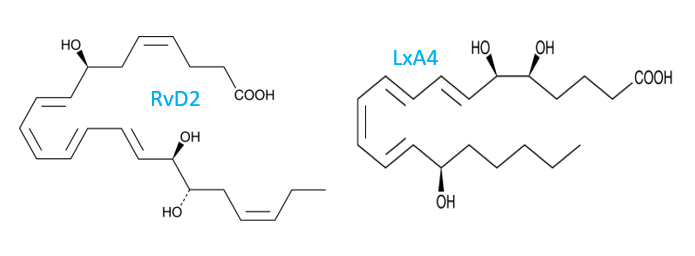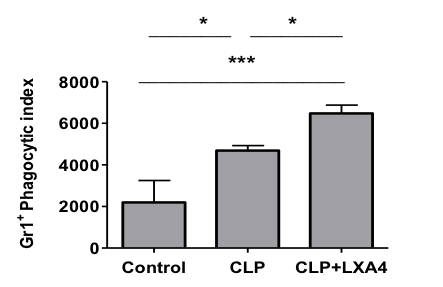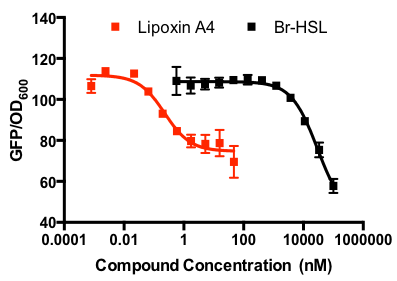Research Interests
Research Interests
Research Interests
Despite advances in antibiotic therapy, there is a significant need for more efficacious treatments of severe bacterial infections. The host responds to bacterial infection by activating the innate immune system to clear pathogen by phagocytic and killing mechanisms. The host then needs to resolve inflammation and return to homeostasis. Resolution is an active process which involves reducing neutrophil activity, increasing macrophage recruitment, augmenting monocyte/macrophage activity, and decreasing systemic inflammatory response. In severe bacterial infections such as sepsis, activation of host response causes massive inflammation which the host is unable to resolve, leading to a later paradoxical dysregulated inflammatory response where the host is immunocompromised and susceptible to secondary infections.
The overarching theme of the Lab is to investigate the effects and mechanisms of action of Specialized Proresolving Mediators (SPMs) and probiotics on host defense and bacterial virulence.

SPMs are endogenously produced lipid mediators with infection resolution activity. They are fatty acid metabolites of arachidonic acid or omega-3 fatty acids (eicosapentaenoic acid; docosahexaenoic acid) found in abundance in fish. The SPM metabolites of arachidonic acid are Lipoxin A4 and B4. The eicosapentaenoic acid metabolites are Resolvins (Rvs of the E-series, and the metabolites of docosahexenoic acid are Rvs of the D series. Probiotics are live organisms (commonly commensal bacteria) which can confer health benefits to the host.
Project 1: To elucidate the cellular and in vivo mechanisms by which SPMs promote host defense in sepsis
SPMs, such as Lipoxin A4 (LXA4), and Resolvins (Rvs) have been shown to increase survival, decrease systemic inflammatory response and reduced bacteria load in cecal ligation and puncture (CLP) sepsis or other models of bacterial infection. Interestingly, LXA4 increased neutrophil phagocytic ability in CLP-sepsis suggesting that SPMs can promote host defense to clear pathogen in sepsis. We are now investigating cellular mechanisms by which RvD2 promotes host defense in a 2-hit model of CLP-sepsis followed by Pseudomonas aeruginosa lung infection.

Blood from septic mice given vehicle saline or LXA4 (7 mg/kg, i.v.) was taken 24h after surgery. Serial dilutions were made and blood was spread on tryptic soy agar plates. After overnight incubation at 370C, colonies were counted by operators blind to the treatment groups. LXA4 reduced blood bacterial load, for n = 10 in both groups. ** P < 0.02.

In vivo effects of LXA4 on blood neutrophil phagocytic ability. 24h after surgery, blood leukocytes were taken from CLP and CLP + LXA4 mice and incubated with opsonized E. coli at 370C for 1h. LXA4 treatment increased neutrophil phagocytic index of neutrophils. Data are mean + s.e.m. * P < 0.05 and *** P 0.01 for n = 8 for all groups.
Project 2: To investigate the direct effects of SPMs on inhibiting quorum sensing and decreasing bacterial virulence
Quorum sensing is a cell density dependent mechanism which regulates expression and release of bacterial virulence factors. We have evidence that LXA4 inhibits binding of the bacterial quorum sensor 3-oxo-C12 HSL in P. aeruginosa with a potency approximately 1000-fold greater than known quorum sensing inhibitors. LXA4 reduced release of the exotoxin - pyocyanin which suggests that LXA4 may reduce bacterial virulence by quorum sensing inhibition. This is the first evidence that an endogenously produced compound can both augment host defense and directly reduce bacterial virulence. We are currently working on the antimicrobial actions of LXA4 on bacteria within established biofilms, and the effects of LXA4 on virulence gene expression.
Clinical Relevance: We believe investigation of SPM mediated mechanisms of antimicrobial activity may have broad applications in bacterial infections and may contribute to new treatments.

Antagonist activity of LXA4 in a GFP-based P. aeruginosa LasR quorum sensing reporter strain. Antagonist activity was determined in the presence of 50nM of the native LasR agonist, 3OC12-HSL Br-HSL is included as a positive control for LasR. antagonism.
Project 3: To investigate the antimicrobial and immunomodulatory actions of Lactobacillus acidophilus cell free products
Lactobacillus acidophilus (L. acidophilus) is a non-pathogenic, commensal bacteria found in human gut microbiome. We have evidence that L. acidophilus and cell free filtrate (CFF) obtained from incubating the bacteria for 6h was bactericidal for Pseudomonas aeruginosa and could destroy established Pseudomonas biofilm. We also have evidence that high concentration CFF could stimulate monocytes and macrophages to release cytokines. This stimulation was due to an increase in nuclear factor kappa-B (NF-kB) activity. On the other hand, low concentration CFF does not stimulate macrophages and can decrease LPS prestimulated release of cytokines. This decrease was due to an inhibition of NF-kB activity. We are now trying to identify the components of this CFF which have bioactivity.
Techniques or models used in the lab include
Whole animal: mouse model of cecal ligation and puncture (CLP) sepsis; intranasal administration of bacteria; i.v. injection of SPMs; bronchoalveolar lavage; blood collection.
Tissue and cells: Flow cytometry, Western Blot; ELISA; Phagocytosis assay; Cell culture; Histology; Quantitative RT-PCR;
Bacteria: Growth assay; biofilm quantitation; biofilm growth under flow conditions in bioreactor; quantitation of bacteria within biofilm using fluorescent microscopy; quantitative RT-PCR of bacterial gene expression.
